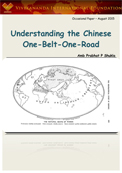… despite multiple flaws, China's expanding participation in Central Asia is a long-term phenomenon and a watershed moment in the post-Soviet history and economic development of these countries… China is the only country capable of mobilising massive investment in the region … under the OBOR, China will continue to be the most important investor in Central Asia …
Retrospect When one talks about Silk Road it conjures up visions of traders and caravans travelling from Occident to the Orient and vice versa. There have been many versions of silk roads which have been used by both traders and invaders for ages. These silk roads connected many cultures and civilizations and these exchanges were largely mutually beneficial. For instance, along with the trade Buddhist religion spread from India to Afghanistan and then to Central Asia, and beyond to China along one of the many silk roads/routes.
A glance at the history of the last few centuries, since at least the seventeenth, indicates that the opening decades of all centuries are times of upheaval. New forces frequently emerge, new ideologies, or technologies. These take time to play themselves out. Without being deterministic about such historical cycles, it seems hard to escape the conclusion that we are witnessing one more turn, and that it will be a while before stability will return.



